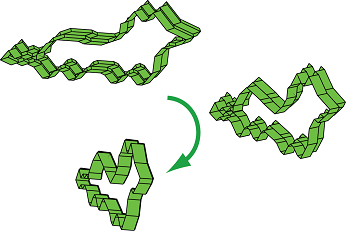Thin sheets can be assembled into origami tubes to create a variety of deployable, reconfigurable, and mechanistically unique three dimensional structures. In this paper Evgueni Filipov, his advisor Professor Glaucio H. Paulino at GA Tech, and Professor Tomohiro Tachi of the University of Tokyo introduce and explore origami tubes with polygonal cross-sections that can reconfigure into numerous geometries. The tubes can be constructed to follow a non-linear curved line when deployed, and their cross-section can be reprogrammed by changing the direction of folding. The paper discusses the variety of tubular structures that can be conceived and it highlights the tunable mechanical characteristics of these systems. This class of origami tubes has potential applications ranging from pipes and micro-robotics to deployable architecture in buildings and building façades.
The work was published in the Proceedings of the Royal Society – A on January 27, 2016.
View Paper: Pre-Print (PDF)
Links to Journal: Full Paper
Online News Coverage
- R&D: “Reconfigurable origami tubes could find antenna, microfluidic uses” on 1/28/2016
- Phys.org: “Reconfigurable origami tubes could find antenna, microfluidic uses” on 1/28/2016
- AZO NANO: “Reconfigurable Origami Tubes May Provide Foundation for Antennas, Microfluidic Uses” on 1/28/2016
- Science Codex: “Reconfigurable origami tubes could find antenna, microfluidic uses” on 1/28/2016
- Georgia Tech School of Civil and Environmental Engineering: “‘Reprogramming’ structures: Paulino’s team creates another new origami design that can be reconfigured for multiple uses” on 1/28/2016
- Georgia Tech News Center: “Reconfigurable Origami Tubes Could Find Antenna, Microfluidic Uses” on 1/28/2016




